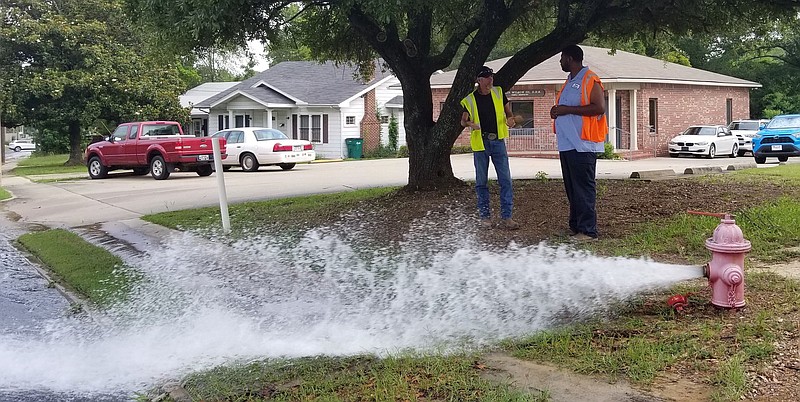The El Dorado Water Utilities is busy with its 2020 water line replacement program, which is focusing on old asbestos cement lines.
Crews began work several weeks ago and the EWU has issued a steady stream of public notices via social media and other means of communication to let residents know the areas in which crews will be working as the project progresses.
With a $500,000 transfer from the EWU reserve coffers to the water budget and help from a rate increase that went into effect in May, the department is starting the arduous task of finding ways to fund the ongoing process of keeping pace with persistent maintenance and repairs that are need for its aging infrastructure and to help cover capital improvement projects.
The EWU and its Water Advisory Board are following recommendations that were laid out in a comprehensive rate and strategic planning study that was conducted earlier this year by Raftelis, a utility and public-sector consulting firm that focuses on finance, organization and technology, including water and wastewater rate studies, cost analyses and financial and strategic planning.
The study concluded that the EWU was not generating enough income to adequately address the issue.
Raftelis also recommended that the EWU reach out to ratepayers to help them understand the state of the city’s aging water/wastewater infrastructure and why a rate increase is needed to generate additional revenue for repairs.
On May 1, rate increases of 2% on the water side and 12% on the wastewater side went into effect, reflecting an increase of about 7% on the average EWU customer’s monthly bill.
Robert Edmonds, director of public works, said both water and wastewater transmission lines are in need of attention but water line replacement, particularly asbestos cement lines, is more pressing.
“When those lines were put in 50 0r 60 years ago, I guess was good material but now, they’re old and brittle and they fall apart with just a little bit of a shift in the earth,” Edmonds said.
There have not been any indications that the lines have posed any public health risks in the area’s drinking water.
The first major leg of the asbestos cement pipe replacement project — and first large-scale water-line replacement project of the year — is along Mount Holly Road between Timberlane and Agnes Road.
Edmonds said the project will affect about 9,500 feet of water lines.
“But we’re not replacing all of that line because there is a parallel line across the road that is 16 inches and the asbestos cement line is a six-inch line,” Edmonds explained. “We’re just boring Mount Holly and tying those services to that 16-inch line.”
Once the project has wrapped on Mount Holly, Edmonds said crews will move just west of town on Ponderosa Road to replace AC lines there.
“The one we’re on now, we’ve got about four or five more weeks on that so probably the first part of August, we’ll be moving to Ponderosa,” he said.
In the meantime, wastewater line replacement projects are being addressed on an as-needed basis with a 2020 budget of $100,000.
Edmonds said such projects are more difficult to schedule because wastewater leaks are often not immediately detected due to gravity issues.
The EWU is also planning a capital improvement project to replace the city’s two wastewater treatment plants, both of which were built in the 1970s and have long surpassed their shelf lives.
The utilities installed a multi-user wastewater transmission line that ferries effluent to the Ouachita River in order to meeting increasingly stringent discharge limits set by environmental agencies, including the Arkansas Department of Environmental Quality, for smaller creeks and streams.
The pipeline, which is also used by industry partners El Dorado Chemical and Lanxess, formerly Great Lakes, went online in 2013 with minimal issues.
By installing the pipeline, Edmonds said EWU got a jump on problems with the deteriorating WWTPs and the utilities wants to stem problems before they worsen at the WWTPs and create bigger problems with treatment and potential violations of environmental laws.
The north plant is located just outside city limits on South Jackson Road and the south plant is located off Calion Road, just north of U.S. 167.
Hawkins-Weir Eingineers, Inc., has been selected to do the design work for the new plants. The most recent cost estimates place the project at $22 million.
Edmonds said conceptual designs should be completed in November or December and once the designs have been approved, the next step will be to explore funding options.
